HRM Report: IT-Based Information Systems for Managerial Decisions
VerifiedAdded on 2023/04/23
|14
|3934
|418
Report
AI Summary
This report examines the crucial role of information technology (IT) in Human Resource Management (HRM) and its impact on organizational success. It details the information needs of HR functions at three managerial levels: operational, tactical, and strategic, explaining how IT-based information systems assist in decision-making at each level. The report further identifies and evaluates examples of how organizations use internet-based information systems, such as websites, intranets, social media, mobile commerce, and the cloud, for HR activities. It also mentions HRIS software like SAP, Peoplesoft, SaaS ERP, ZingHR Cloud HCM, SumHR Cloud Payroll and HR Software, BambooHR and Zoho People along with their vendors. The report concludes by emphasizing the interrelation between human resource functions and information technology, highlighting their mutual influence.
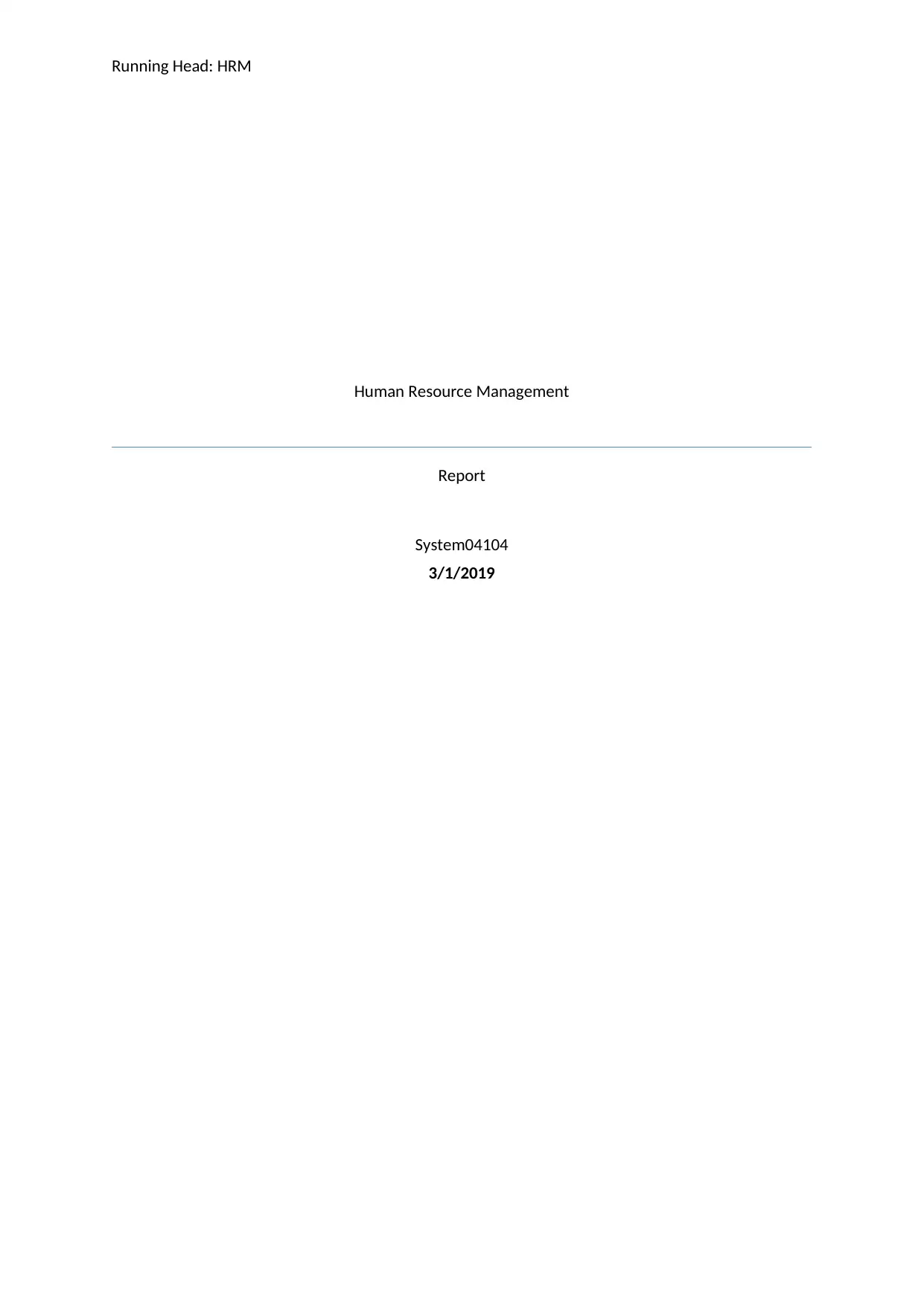
Running Head: HRM
Human Resource Management
Report
System04104
3/1/2019
Human Resource Management
Report
System04104
3/1/2019
Paraphrase This Document
Need a fresh take? Get an instant paraphrase of this document with our AI Paraphraser

HRM
1
Table of Contents
1. Introduction...................................................................................................................................2
2. Need of Information in the HR functions at the three levels of Managerial Decision-making.......3
2.1 Operational Level.........................................................................................................................3
2.2 Tactical Level................................................................................................................................4
2.3 Strategic Level..............................................................................................................................5
3. IT based Information Systems in HR..............................................................................................5
3.1 Types of IT based IS in HR............................................................................................................5
3.1.1 Operational HRIS.................................................................................................................5
3.1.2 Tactical HRIS.........................................................................................................................6
3.1.3 Strategic HRIS.......................................................................................................................7
3.2 Best HR information system and Vendors/Developers..........................................................7
5. Internet based Information System in HR......................................................................................8
6. Conclusion...................................................................................................................................10
References...........................................................................................................................................11
1
Table of Contents
1. Introduction...................................................................................................................................2
2. Need of Information in the HR functions at the three levels of Managerial Decision-making.......3
2.1 Operational Level.........................................................................................................................3
2.2 Tactical Level................................................................................................................................4
2.3 Strategic Level..............................................................................................................................5
3. IT based Information Systems in HR..............................................................................................5
3.1 Types of IT based IS in HR............................................................................................................5
3.1.1 Operational HRIS.................................................................................................................5
3.1.2 Tactical HRIS.........................................................................................................................6
3.1.3 Strategic HRIS.......................................................................................................................7
3.2 Best HR information system and Vendors/Developers..........................................................7
5. Internet based Information System in HR......................................................................................8
6. Conclusion...................................................................................................................................10
References...........................................................................................................................................11
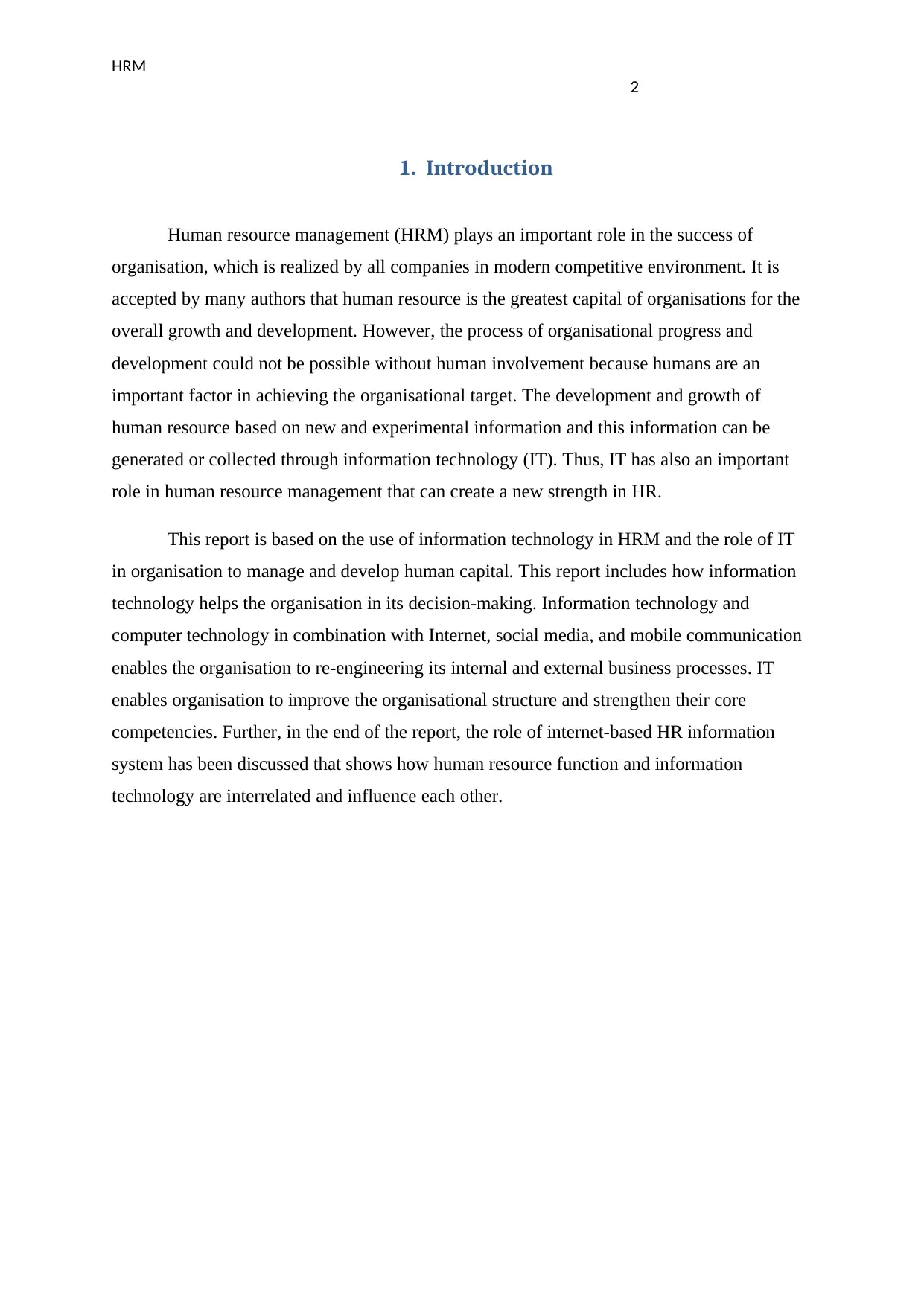
HRM
2
1. Introduction
Human resource management (HRM) plays an important role in the success of
organisation, which is realized by all companies in modern competitive environment. It is
accepted by many authors that human resource is the greatest capital of organisations for the
overall growth and development. However, the process of organisational progress and
development could not be possible without human involvement because humans are an
important factor in achieving the organisational target. The development and growth of
human resource based on new and experimental information and this information can be
generated or collected through information technology (IT). Thus, IT has also an important
role in human resource management that can create a new strength in HR.
This report is based on the use of information technology in HRM and the role of IT
in organisation to manage and develop human capital. This report includes how information
technology helps the organisation in its decision-making. Information technology and
computer technology in combination with Internet, social media, and mobile communication
enables the organisation to re-engineering its internal and external business processes. IT
enables organisation to improve the organisational structure and strengthen their core
competencies. Further, in the end of the report, the role of internet-based HR information
system has been discussed that shows how human resource function and information
technology are interrelated and influence each other.
2
1. Introduction
Human resource management (HRM) plays an important role in the success of
organisation, which is realized by all companies in modern competitive environment. It is
accepted by many authors that human resource is the greatest capital of organisations for the
overall growth and development. However, the process of organisational progress and
development could not be possible without human involvement because humans are an
important factor in achieving the organisational target. The development and growth of
human resource based on new and experimental information and this information can be
generated or collected through information technology (IT). Thus, IT has also an important
role in human resource management that can create a new strength in HR.
This report is based on the use of information technology in HRM and the role of IT
in organisation to manage and develop human capital. This report includes how information
technology helps the organisation in its decision-making. Information technology and
computer technology in combination with Internet, social media, and mobile communication
enables the organisation to re-engineering its internal and external business processes. IT
enables organisation to improve the organisational structure and strengthen their core
competencies. Further, in the end of the report, the role of internet-based HR information
system has been discussed that shows how human resource function and information
technology are interrelated and influence each other.
⊘ This is a preview!⊘
Do you want full access?
Subscribe today to unlock all pages.

Trusted by 1+ million students worldwide
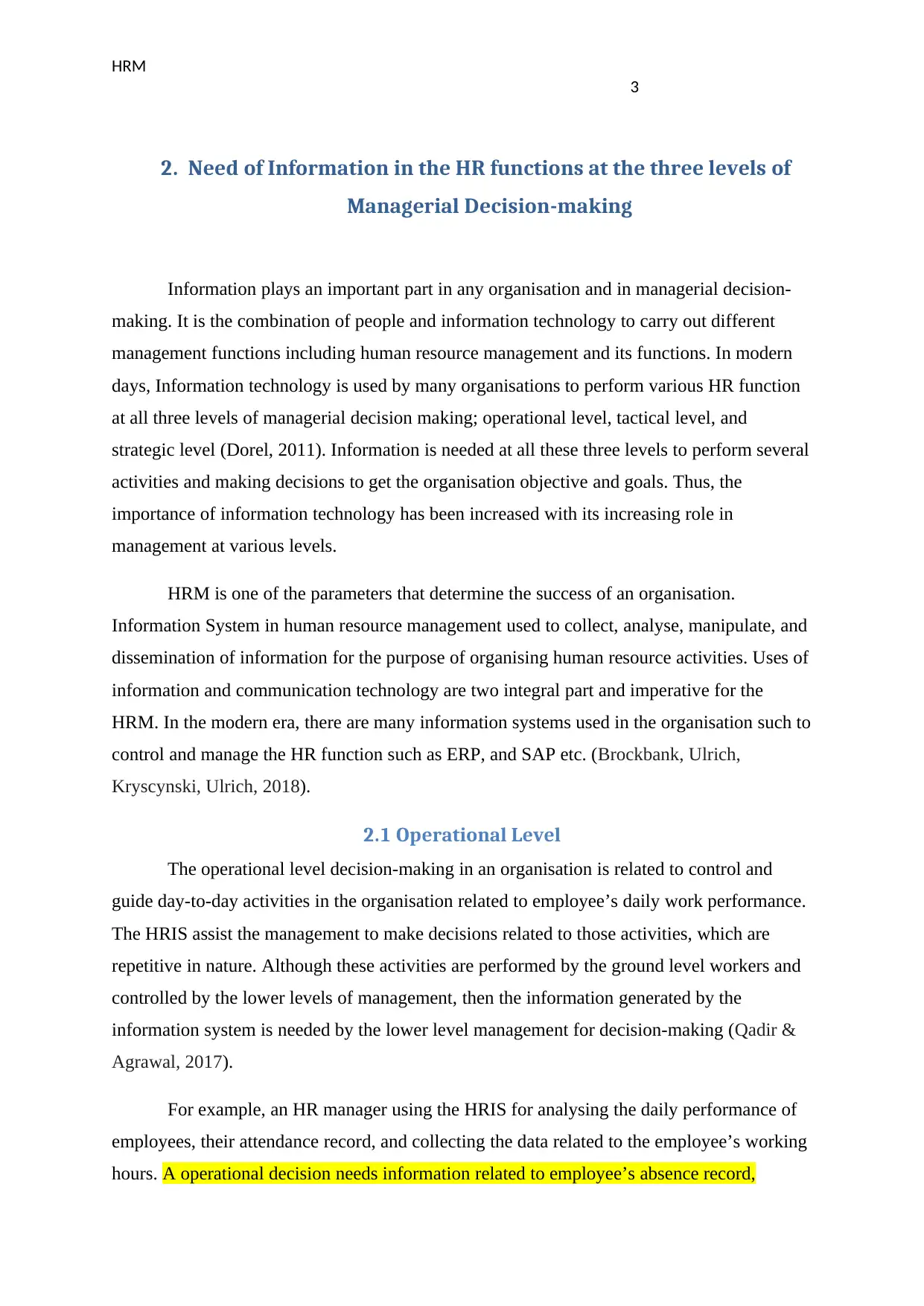
HRM
3
2. Need of Information in the HR functions at the three levels of
Managerial Decision-making
Information plays an important part in any organisation and in managerial decision-
making. It is the combination of people and information technology to carry out different
management functions including human resource management and its functions. In modern
days, Information technology is used by many organisations to perform various HR function
at all three levels of managerial decision making; operational level, tactical level, and
strategic level (Dorel, 2011). Information is needed at all these three levels to perform several
activities and making decisions to get the organisation objective and goals. Thus, the
importance of information technology has been increased with its increasing role in
management at various levels.
HRM is one of the parameters that determine the success of an organisation.
Information System in human resource management used to collect, analyse, manipulate, and
dissemination of information for the purpose of organising human resource activities. Uses of
information and communication technology are two integral part and imperative for the
HRM. In the modern era, there are many information systems used in the organisation such to
control and manage the HR function such as ERP, and SAP etc. (Brockbank, Ulrich,
Kryscynski, Ulrich, 2018).
2.1 Operational Level
The operational level decision-making in an organisation is related to control and
guide day-to-day activities in the organisation related to employee’s daily work performance.
The HRIS assist the management to make decisions related to those activities, which are
repetitive in nature. Although these activities are performed by the ground level workers and
controlled by the lower levels of management, then the information generated by the
information system is needed by the lower level management for decision-making (Qadir &
Agrawal, 2017).
For example, an HR manager using the HRIS for analysing the daily performance of
employees, their attendance record, and collecting the data related to the employee’s working
hours. A operational decision needs information related to employee’s absence record,
3
2. Need of Information in the HR functions at the three levels of
Managerial Decision-making
Information plays an important part in any organisation and in managerial decision-
making. It is the combination of people and information technology to carry out different
management functions including human resource management and its functions. In modern
days, Information technology is used by many organisations to perform various HR function
at all three levels of managerial decision making; operational level, tactical level, and
strategic level (Dorel, 2011). Information is needed at all these three levels to perform several
activities and making decisions to get the organisation objective and goals. Thus, the
importance of information technology has been increased with its increasing role in
management at various levels.
HRM is one of the parameters that determine the success of an organisation.
Information System in human resource management used to collect, analyse, manipulate, and
dissemination of information for the purpose of organising human resource activities. Uses of
information and communication technology are two integral part and imperative for the
HRM. In the modern era, there are many information systems used in the organisation such to
control and manage the HR function such as ERP, and SAP etc. (Brockbank, Ulrich,
Kryscynski, Ulrich, 2018).
2.1 Operational Level
The operational level decision-making in an organisation is related to control and
guide day-to-day activities in the organisation related to employee’s daily work performance.
The HRIS assist the management to make decisions related to those activities, which are
repetitive in nature. Although these activities are performed by the ground level workers and
controlled by the lower levels of management, then the information generated by the
information system is needed by the lower level management for decision-making (Qadir &
Agrawal, 2017).
For example, an HR manager using the HRIS for analysing the daily performance of
employees, their attendance record, and collecting the data related to the employee’s working
hours. A operational decision needs information related to employee’s absence record,
Paraphrase This Document
Need a fresh take? Get an instant paraphrase of this document with our AI Paraphraser

HRM
4
managing organisational resources, job allocation, employees’ health and safety,
communication and change, job evaluation, job rotation, etc. (Nath & Satardekar, 2015).
(Source: Ruth, Brush, & Ryu, 2015)
2.2 Tactical Level
Tactical decision-making requires information related to recruitment and selection of
employees, number of unfilled positions in the organisation, information related to job
allocation, employee recruitment, etc. Tactical decision-making requires also requires
information regarding employees job analysis and evaluation, issues of labour unions etc.
Tactical decision making also requires information about those employees who needs training
and skill development program.
Tactical information plays a crucial role in allocating resources and implementing
top-level management plans in the organisation. Middle-Level management uses tactical
information for short-term trends. Tactical information is generally prognostic and predictive
in nature. The tactical information may be retrieved from partly current or historical sources.
It belongs to both internal and external sources. The tactical information is needed by middle-
level management because it helps them in making better decisions (Jeske & Axtell, 2017).
Managers can also use real-time tactical information while making any decision.
4
managing organisational resources, job allocation, employees’ health and safety,
communication and change, job evaluation, job rotation, etc. (Nath & Satardekar, 2015).
(Source: Ruth, Brush, & Ryu, 2015)
2.2 Tactical Level
Tactical decision-making requires information related to recruitment and selection of
employees, number of unfilled positions in the organisation, information related to job
allocation, employee recruitment, etc. Tactical decision-making requires also requires
information regarding employees job analysis and evaluation, issues of labour unions etc.
Tactical decision making also requires information about those employees who needs training
and skill development program.
Tactical information plays a crucial role in allocating resources and implementing
top-level management plans in the organisation. Middle-Level management uses tactical
information for short-term trends. Tactical information is generally prognostic and predictive
in nature. The tactical information may be retrieved from partly current or historical sources.
It belongs to both internal and external sources. The tactical information is needed by middle-
level management because it helps them in making better decisions (Jeske & Axtell, 2017).
Managers can also use real-time tactical information while making any decision.
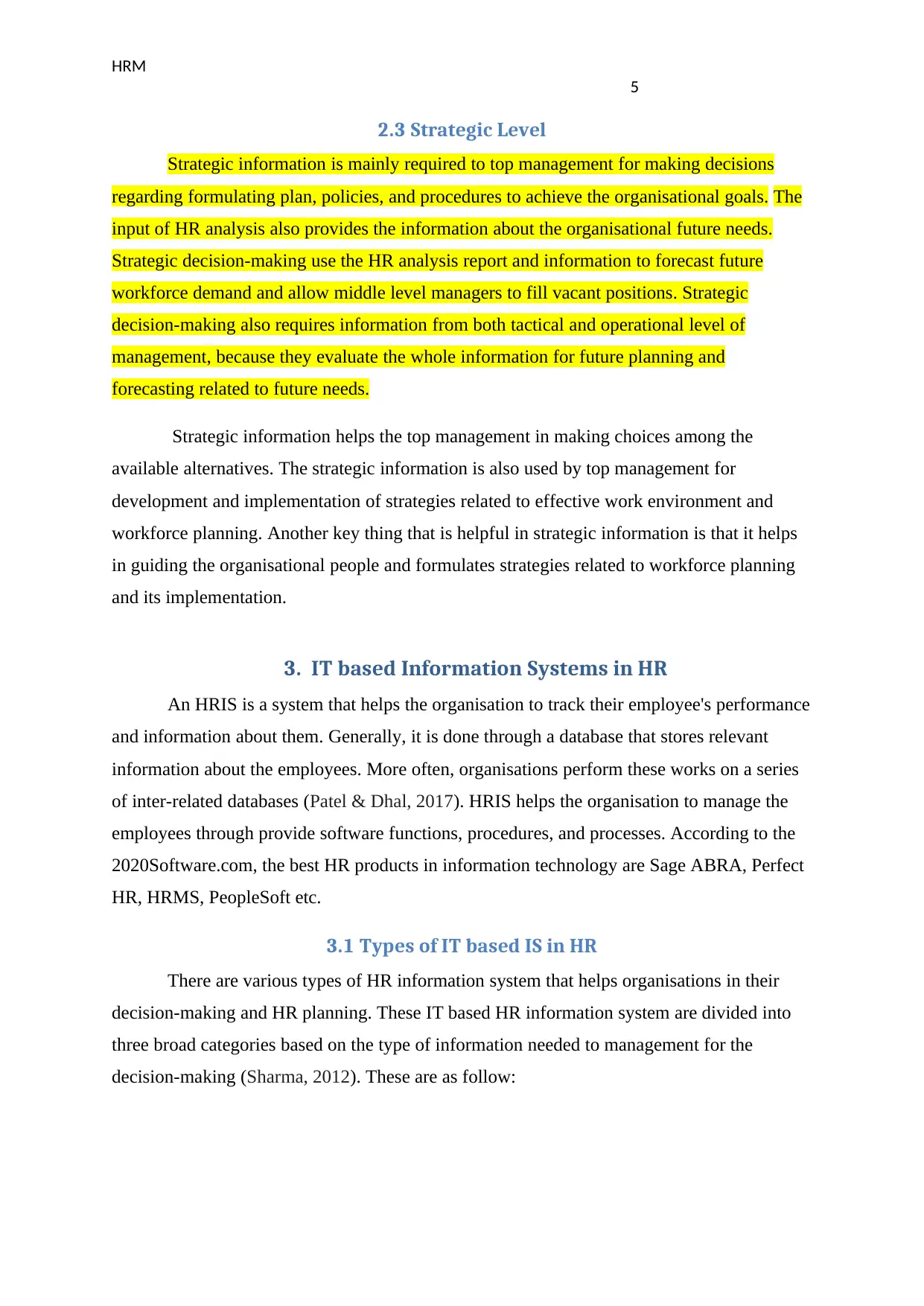
HRM
5
2.3 Strategic Level
Strategic information is mainly required to top management for making decisions
regarding formulating plan, policies, and procedures to achieve the organisational goals. The
input of HR analysis also provides the information about the organisational future needs.
Strategic decision-making use the HR analysis report and information to forecast future
workforce demand and allow middle level managers to fill vacant positions. Strategic
decision-making also requires information from both tactical and operational level of
management, because they evaluate the whole information for future planning and
forecasting related to future needs.
Strategic information helps the top management in making choices among the
available alternatives. The strategic information is also used by top management for
development and implementation of strategies related to effective work environment and
workforce planning. Another key thing that is helpful in strategic information is that it helps
in guiding the organisational people and formulates strategies related to workforce planning
and its implementation.
3. IT based Information Systems in HR
An HRIS is a system that helps the organisation to track their employee's performance
and information about them. Generally, it is done through a database that stores relevant
information about the employees. More often, organisations perform these works on a series
of inter-related databases (Patel & Dhal, 2017). HRIS helps the organisation to manage the
employees through provide software functions, procedures, and processes. According to the
2020Software.com, the best HR products in information technology are Sage ABRA, Perfect
HR, HRMS, PeopleSoft etc.
3.1 Types of IT based IS in HR
There are various types of HR information system that helps organisations in their
decision-making and HR planning. These IT based HR information system are divided into
three broad categories based on the type of information needed to management for the
decision-making (Sharma, 2012). These are as follow:
5
2.3 Strategic Level
Strategic information is mainly required to top management for making decisions
regarding formulating plan, policies, and procedures to achieve the organisational goals. The
input of HR analysis also provides the information about the organisational future needs.
Strategic decision-making use the HR analysis report and information to forecast future
workforce demand and allow middle level managers to fill vacant positions. Strategic
decision-making also requires information from both tactical and operational level of
management, because they evaluate the whole information for future planning and
forecasting related to future needs.
Strategic information helps the top management in making choices among the
available alternatives. The strategic information is also used by top management for
development and implementation of strategies related to effective work environment and
workforce planning. Another key thing that is helpful in strategic information is that it helps
in guiding the organisational people and formulates strategies related to workforce planning
and its implementation.
3. IT based Information Systems in HR
An HRIS is a system that helps the organisation to track their employee's performance
and information about them. Generally, it is done through a database that stores relevant
information about the employees. More often, organisations perform these works on a series
of inter-related databases (Patel & Dhal, 2017). HRIS helps the organisation to manage the
employees through provide software functions, procedures, and processes. According to the
2020Software.com, the best HR products in information technology are Sage ABRA, Perfect
HR, HRMS, PeopleSoft etc.
3.1 Types of IT based IS in HR
There are various types of HR information system that helps organisations in their
decision-making and HR planning. These IT based HR information system are divided into
three broad categories based on the type of information needed to management for the
decision-making (Sharma, 2012). These are as follow:
⊘ This is a preview!⊘
Do you want full access?
Subscribe today to unlock all pages.

Trusted by 1+ million students worldwide
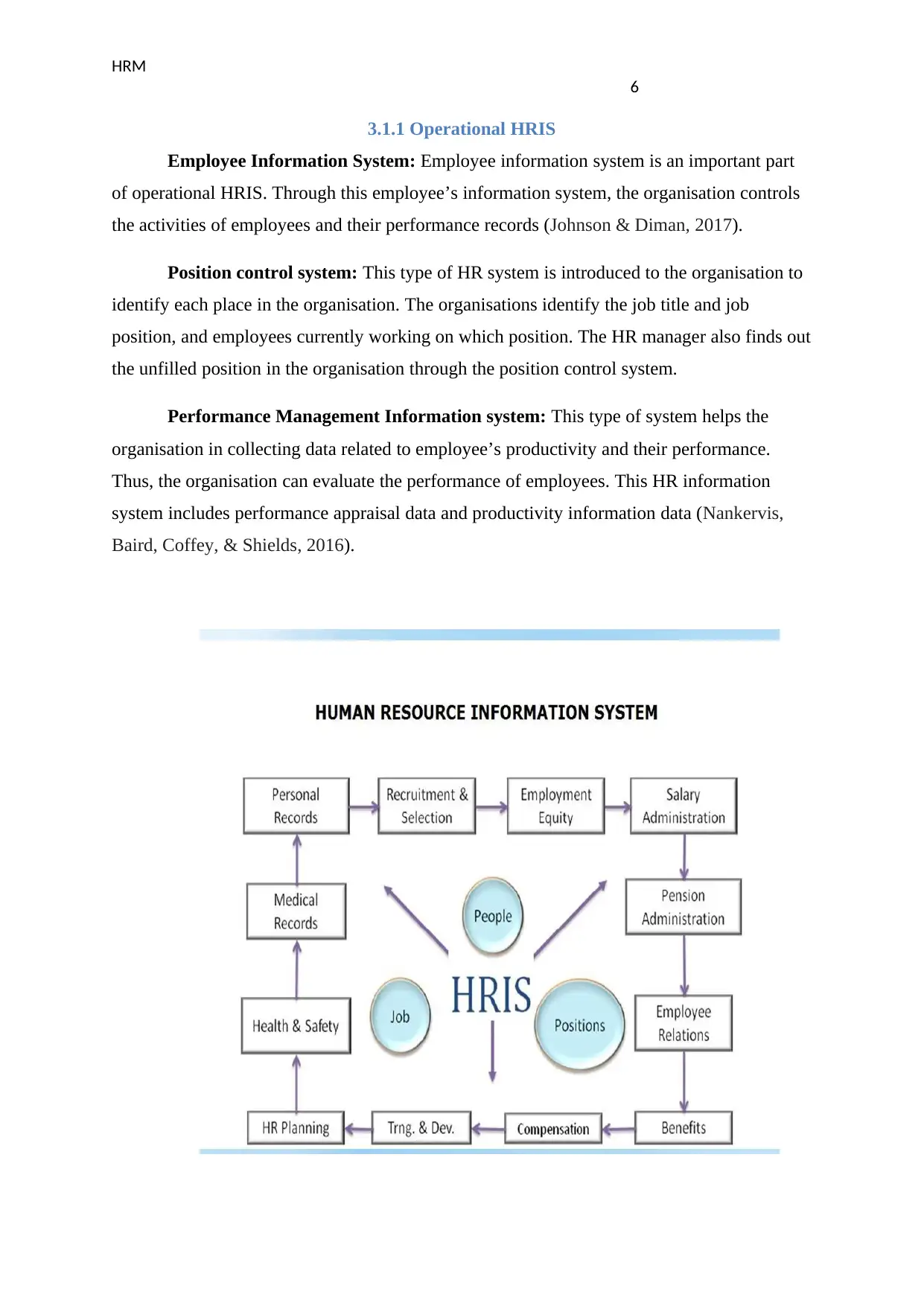
HRM
6
3.1.1 Operational HRIS
Employee Information System: Employee information system is an important part
of operational HRIS. Through this employee’s information system, the organisation controls
the activities of employees and their performance records (Johnson & Diman, 2017).
Position control system: This type of HR system is introduced to the organisation to
identify each place in the organisation. The organisations identify the job title and job
position, and employees currently working on which position. The HR manager also finds out
the unfilled position in the organisation through the position control system.
Performance Management Information system: This type of system helps the
organisation in collecting data related to employee’s productivity and their performance.
Thus, the organisation can evaluate the performance of employees. This HR information
system includes performance appraisal data and productivity information data (Nankervis,
Baird, Coffey, & Shields, 2016).
6
3.1.1 Operational HRIS
Employee Information System: Employee information system is an important part
of operational HRIS. Through this employee’s information system, the organisation controls
the activities of employees and their performance records (Johnson & Diman, 2017).
Position control system: This type of HR system is introduced to the organisation to
identify each place in the organisation. The organisations identify the job title and job
position, and employees currently working on which position. The HR manager also finds out
the unfilled position in the organisation through the position control system.
Performance Management Information system: This type of system helps the
organisation in collecting data related to employee’s productivity and their performance.
Thus, the organisation can evaluate the performance of employees. This HR information
system includes performance appraisal data and productivity information data (Nankervis,
Baird, Coffey, & Shields, 2016).
Paraphrase This Document
Need a fresh take? Get an instant paraphrase of this document with our AI Paraphraser

HRM
7
(Source: Sheehan, De Cieri, Cooper, & Shea, 2016)
3.1.2 Tactical HRIS
Job Analysis and Design Information System: The job analysis and design system
retrieve data from supervisors and workers. Input is also taken as information from the
external as well as internal sources such as labour unions, competitors, governments, firms,
etc.
Recruiting Information system: The recruiting Information system helps the
organisation in directing and recruiting functions to develop a proper recruiting plan. The
organisation uses this system to fill the different post and position in the organisation with
skilled and talented people. A proper recruiting system helps the organisation to recruit
employees and helps the organisation to complete the recruiting process effectively (Haji &
Ahmed, 2017).
Compensation and Benefit Information System: This HRIS helps the organisation
to support different tactical decisions related to human resource compensation and benefits
function because it plays an important role in overall productivity of the organisation (Singh,
& Lenka, 2018).
Employees Training and Development System: It is another important HR
information system that plays a vital role in employee training and development function.
This information system helps the organisation to direct the training program for those
employees in the organisation who are benefiting from it.
3.1.3 Strategic HRIS
The strategic information system in HR helps the organisation in making decisions
regarding workforce planning and labour negotiations etc. The main idea behind
implementing the strategic information system is to develop a good idea about workforce
planning and labour resources. The major types of strategic HRIS are as follow:
Information System Supporting Workforce Planning: This type of software often
helps in those circumstances where an organisation is planning to expand the business in new
market areas, add new products, or construct new offices or factories in new locations. This
all need accurate and precise information about the available workforce regarding the quality
and quantity of the workforce to achieve these new goals (Hashim & Tan, 2015). Therefore,
7
(Source: Sheehan, De Cieri, Cooper, & Shea, 2016)
3.1.2 Tactical HRIS
Job Analysis and Design Information System: The job analysis and design system
retrieve data from supervisors and workers. Input is also taken as information from the
external as well as internal sources such as labour unions, competitors, governments, firms,
etc.
Recruiting Information system: The recruiting Information system helps the
organisation in directing and recruiting functions to develop a proper recruiting plan. The
organisation uses this system to fill the different post and position in the organisation with
skilled and talented people. A proper recruiting system helps the organisation to recruit
employees and helps the organisation to complete the recruiting process effectively (Haji &
Ahmed, 2017).
Compensation and Benefit Information System: This HRIS helps the organisation
to support different tactical decisions related to human resource compensation and benefits
function because it plays an important role in overall productivity of the organisation (Singh,
& Lenka, 2018).
Employees Training and Development System: It is another important HR
information system that plays a vital role in employee training and development function.
This information system helps the organisation to direct the training program for those
employees in the organisation who are benefiting from it.
3.1.3 Strategic HRIS
The strategic information system in HR helps the organisation in making decisions
regarding workforce planning and labour negotiations etc. The main idea behind
implementing the strategic information system is to develop a good idea about workforce
planning and labour resources. The major types of strategic HRIS are as follow:
Information System Supporting Workforce Planning: This type of software often
helps in those circumstances where an organisation is planning to expand the business in new
market areas, add new products, or construct new offices or factories in new locations. This
all need accurate and precise information about the available workforce regarding the quality
and quantity of the workforce to achieve these new goals (Hashim & Tan, 2015). Therefore,
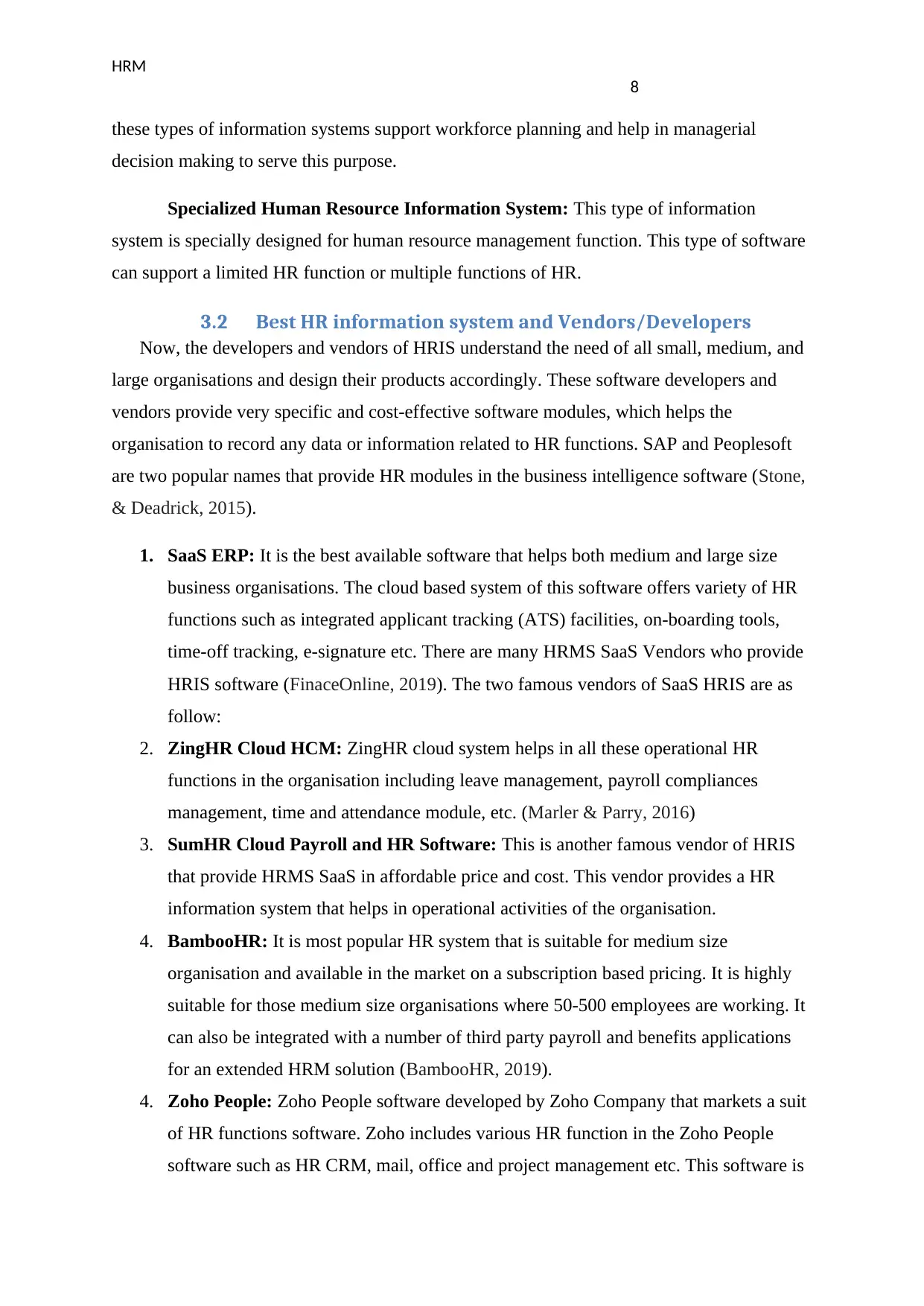
HRM
8
these types of information systems support workforce planning and help in managerial
decision making to serve this purpose.
Specialized Human Resource Information System: This type of information
system is specially designed for human resource management function. This type of software
can support a limited HR function or multiple functions of HR.
3.2 Best HR information system and Vendors/Developers
Now, the developers and vendors of HRIS understand the need of all small, medium, and
large organisations and design their products accordingly. These software developers and
vendors provide very specific and cost-effective software modules, which helps the
organisation to record any data or information related to HR functions. SAP and Peoplesoft
are two popular names that provide HR modules in the business intelligence software (Stone,
& Deadrick, 2015).
1. SaaS ERP: It is the best available software that helps both medium and large size
business organisations. The cloud based system of this software offers variety of HR
functions such as integrated applicant tracking (ATS) facilities, on-boarding tools,
time-off tracking, e-signature etc. There are many HRMS SaaS Vendors who provide
HRIS software (FinaceOnline, 2019). The two famous vendors of SaaS HRIS are as
follow:
2. ZingHR Cloud HCM: ZingHR cloud system helps in all these operational HR
functions in the organisation including leave management, payroll compliances
management, time and attendance module, etc. (Marler & Parry, 2016)
3. SumHR Cloud Payroll and HR Software: This is another famous vendor of HRIS
that provide HRMS SaaS in affordable price and cost. This vendor provides a HR
information system that helps in operational activities of the organisation.
4. BambooHR: It is most popular HR system that is suitable for medium size
organisation and available in the market on a subscription based pricing. It is highly
suitable for those medium size organisations where 50-500 employees are working. It
can also be integrated with a number of third party payroll and benefits applications
for an extended HRM solution (BambooHR, 2019).
4. Zoho People: Zoho People software developed by Zoho Company that markets a suit
of HR functions software. Zoho includes various HR function in the Zoho People
software such as HR CRM, mail, office and project management etc. This software is
8
these types of information systems support workforce planning and help in managerial
decision making to serve this purpose.
Specialized Human Resource Information System: This type of information
system is specially designed for human resource management function. This type of software
can support a limited HR function or multiple functions of HR.
3.2 Best HR information system and Vendors/Developers
Now, the developers and vendors of HRIS understand the need of all small, medium, and
large organisations and design their products accordingly. These software developers and
vendors provide very specific and cost-effective software modules, which helps the
organisation to record any data or information related to HR functions. SAP and Peoplesoft
are two popular names that provide HR modules in the business intelligence software (Stone,
& Deadrick, 2015).
1. SaaS ERP: It is the best available software that helps both medium and large size
business organisations. The cloud based system of this software offers variety of HR
functions such as integrated applicant tracking (ATS) facilities, on-boarding tools,
time-off tracking, e-signature etc. There are many HRMS SaaS Vendors who provide
HRIS software (FinaceOnline, 2019). The two famous vendors of SaaS HRIS are as
follow:
2. ZingHR Cloud HCM: ZingHR cloud system helps in all these operational HR
functions in the organisation including leave management, payroll compliances
management, time and attendance module, etc. (Marler & Parry, 2016)
3. SumHR Cloud Payroll and HR Software: This is another famous vendor of HRIS
that provide HRMS SaaS in affordable price and cost. This vendor provides a HR
information system that helps in operational activities of the organisation.
4. BambooHR: It is most popular HR system that is suitable for medium size
organisation and available in the market on a subscription based pricing. It is highly
suitable for those medium size organisations where 50-500 employees are working. It
can also be integrated with a number of third party payroll and benefits applications
for an extended HRM solution (BambooHR, 2019).
4. Zoho People: Zoho People software developed by Zoho Company that markets a suit
of HR functions software. Zoho includes various HR function in the Zoho People
software such as HR CRM, mail, office and project management etc. This software is
⊘ This is a preview!⊘
Do you want full access?
Subscribe today to unlock all pages.

Trusted by 1+ million students worldwide

HRM
9
also provided by many vendors such as ZingHR Cloud HCM and SumHR Cloud
Payroll and HR Software etc. because it has more demand in the market.
Apart from these vendors, there are many vendors that provide SaaS ERP, PeopleSoft and
SAP HRIS such as EMERGE App, Bright Pearl, ERP next, Megaventory etc.
5. Internet based Information System in HR
In modern days, the role of the Internet has been growing tremendously because it
facilitates organisations in the communication, coordination, and management of the
enterprise. Many organisations are currently using the Internet and web-based services to
speed up the business processes and provide a stage to their customer for buying, selling, and
deliver the product or service at a very low cost. The organisation designed their business
process around the technologies and re-inventing the business model on regular basis. E-
commerce and E-business are two most popular term in the modern era (Tong, Tak, & Wong,
2015).
Internet provides instant access to the information related to the employee’s
performance and productivity. Internet based HR information system allows the organisation
to exchange the information between the organisation and employees with greater ease and
without the need of hard paper. Internet based information system not only reduce the
organisation costs rather it also reduces the time used in HR activities. People can exchange
information through the Internet based information system to a centralized location from
anywhere through the company's portal or external web links (Sulochana & Sajeewanie,
2015). A location is designed in the company which is centralized and can be accessed from
anywhere within the company. This further leads to the effective work performance of the
employee and reduce the redundancy within the organisation.
The internet or web-based information system helps the organisation in reporting and
analysing the employee information. It also helps in guiding employees through internet
based organisational guidelines, emergency evacuation procedures, and safety guidelines.
The organisation can also track the applicant during the recruitment process in the
organisation through the email and other web-based communication channels such as
company’s portal or social media platform. The web-based HR information system has a high
degree of capability to provide an instant solution for the employee's problem. There are
9
also provided by many vendors such as ZingHR Cloud HCM and SumHR Cloud
Payroll and HR Software etc. because it has more demand in the market.
Apart from these vendors, there are many vendors that provide SaaS ERP, PeopleSoft and
SAP HRIS such as EMERGE App, Bright Pearl, ERP next, Megaventory etc.
5. Internet based Information System in HR
In modern days, the role of the Internet has been growing tremendously because it
facilitates organisations in the communication, coordination, and management of the
enterprise. Many organisations are currently using the Internet and web-based services to
speed up the business processes and provide a stage to their customer for buying, selling, and
deliver the product or service at a very low cost. The organisation designed their business
process around the technologies and re-inventing the business model on regular basis. E-
commerce and E-business are two most popular term in the modern era (Tong, Tak, & Wong,
2015).
Internet provides instant access to the information related to the employee’s
performance and productivity. Internet based HR information system allows the organisation
to exchange the information between the organisation and employees with greater ease and
without the need of hard paper. Internet based information system not only reduce the
organisation costs rather it also reduces the time used in HR activities. People can exchange
information through the Internet based information system to a centralized location from
anywhere through the company's portal or external web links (Sulochana & Sajeewanie,
2015). A location is designed in the company which is centralized and can be accessed from
anywhere within the company. This further leads to the effective work performance of the
employee and reduce the redundancy within the organisation.
The internet or web-based information system helps the organisation in reporting and
analysing the employee information. It also helps in guiding employees through internet
based organisational guidelines, emergency evacuation procedures, and safety guidelines.
The organisation can also track the applicant during the recruitment process in the
organisation through the email and other web-based communication channels such as
company’s portal or social media platform. The web-based HR information system has a high
degree of capability to provide an instant solution for the employee's problem. There are
Paraphrase This Document
Need a fresh take? Get an instant paraphrase of this document with our AI Paraphraser

HRM
10
many companies that provide internet based information system that helps their employees
and guide them on the spot through the company portal or site (Ulrich & Brockbank, 2016).
The major problem is regarding the human resource information system is that low
budget organisation cannot afford the cost of its implantation. The major problem with HRIS
is that only large companies have started using HRIS to support their HR activities. However,
this problem is generally solved by the internet based human resource information system
because it provides many facilities for the organisation. Internet-based HR information
systems not only improve communication, but it also helps in employee’s productivity (Van
Knippenberg, Dahlander, Haas, & George, 2015). The main reason for the delay in HRIS
implementation in the organisation is people resisted the change because technological
change created fear in the mind of people. A large number of organisations are struggling to
implement these technologies because people resisted it. Other reason behind this is people
lack in technological knowledge and skills. However, the trends are changing now because
more and more organisation realizes the importance of IT and technology.
6. Conclusion
In conclusion, internet and technology play a vital role in human resource
management and its functions. In modern days, computer technology and information
technology are the essential need of every organisation to stay productive and competitive in
the market. IT and Internet technology not only enhance the performance of employees, but it
also facilitates organisations to cost and time effective communication between employees
and the organisation. IT and technology in the HR function has created a new way of HR
processes applications. IT helps the organisation in virtual recruitment and E-learning etc.
The major advantage of Internet and information technology in HR is that it enhances the
productivity of people and provides a common platform for people to raise their issues or
retrieve information about their performance. However, the role of HRIS helps the
management in their decision-making that further leads to the high level of employee's
productivity and high quality of customer service. However, the major drawback of using the
HRIS in any organisation is that it shrinks the job opportunities in the organisation and a
larger number of people become unemployed or in fear to lose the job.
10
many companies that provide internet based information system that helps their employees
and guide them on the spot through the company portal or site (Ulrich & Brockbank, 2016).
The major problem is regarding the human resource information system is that low
budget organisation cannot afford the cost of its implantation. The major problem with HRIS
is that only large companies have started using HRIS to support their HR activities. However,
this problem is generally solved by the internet based human resource information system
because it provides many facilities for the organisation. Internet-based HR information
systems not only improve communication, but it also helps in employee’s productivity (Van
Knippenberg, Dahlander, Haas, & George, 2015). The main reason for the delay in HRIS
implementation in the organisation is people resisted the change because technological
change created fear in the mind of people. A large number of organisations are struggling to
implement these technologies because people resisted it. Other reason behind this is people
lack in technological knowledge and skills. However, the trends are changing now because
more and more organisation realizes the importance of IT and technology.
6. Conclusion
In conclusion, internet and technology play a vital role in human resource
management and its functions. In modern days, computer technology and information
technology are the essential need of every organisation to stay productive and competitive in
the market. IT and Internet technology not only enhance the performance of employees, but it
also facilitates organisations to cost and time effective communication between employees
and the organisation. IT and technology in the HR function has created a new way of HR
processes applications. IT helps the organisation in virtual recruitment and E-learning etc.
The major advantage of Internet and information technology in HR is that it enhances the
productivity of people and provides a common platform for people to raise their issues or
retrieve information about their performance. However, the role of HRIS helps the
management in their decision-making that further leads to the high level of employee's
productivity and high quality of customer service. However, the major drawback of using the
HRIS in any organisation is that it shrinks the job opportunities in the organisation and a
larger number of people become unemployed or in fear to lose the job.
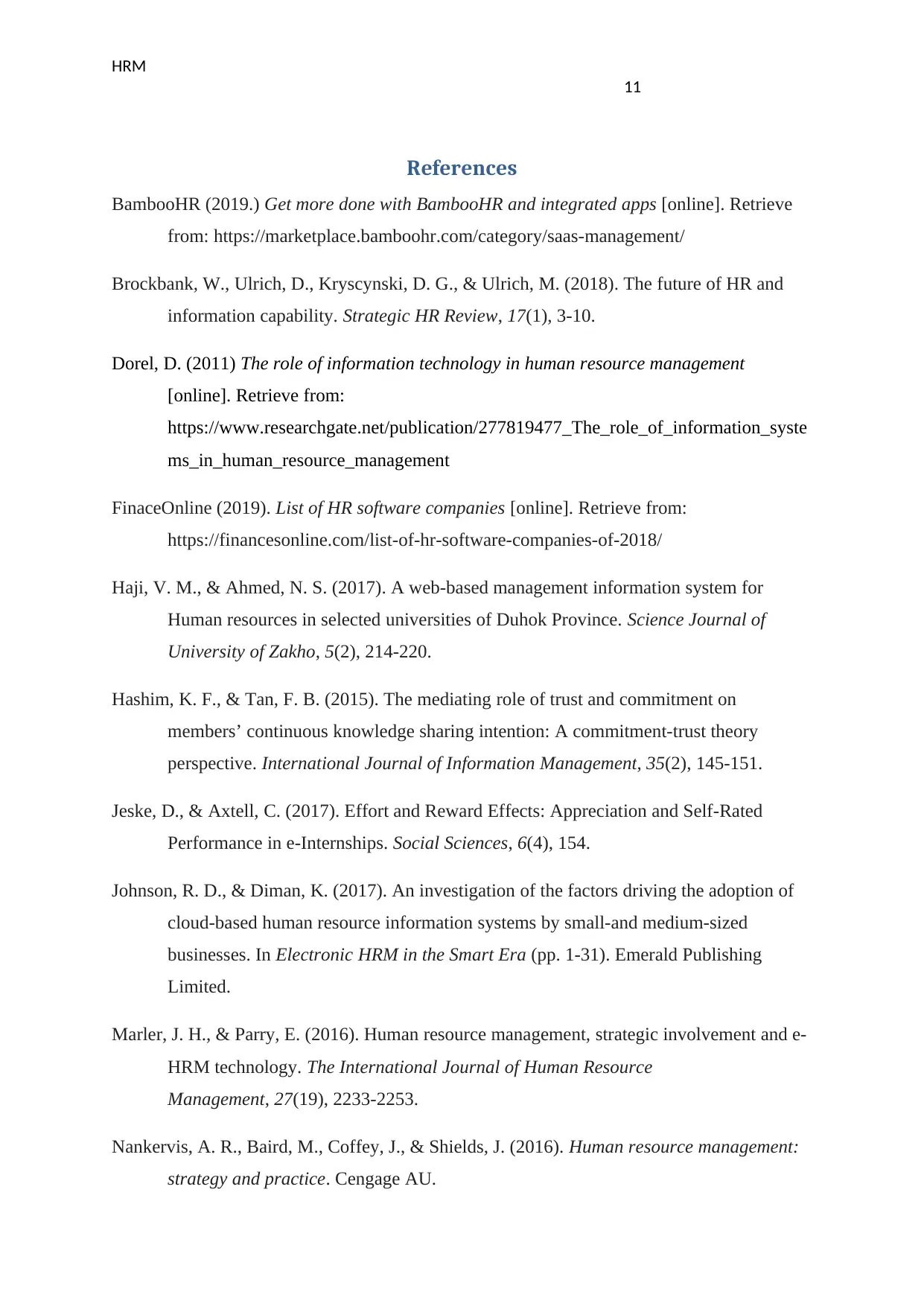
HRM
11
References
BambooHR (2019.) Get more done with BambooHR and integrated apps [online]. Retrieve
from: https://marketplace.bamboohr.com/category/saas-management/
Brockbank, W., Ulrich, D., Kryscynski, D. G., & Ulrich, M. (2018). The future of HR and
information capability. Strategic HR Review, 17(1), 3-10.
Dorel, D. (2011) The role of information technology in human resource management
[online]. Retrieve from:
https://www.researchgate.net/publication/277819477_The_role_of_information_syste
ms_in_human_resource_management
FinaceOnline (2019). List of HR software companies [online]. Retrieve from:
https://financesonline.com/list-of-hr-software-companies-of-2018/
Haji, V. M., & Ahmed, N. S. (2017). A web-based management information system for
Human resources in selected universities of Duhok Province. Science Journal of
University of Zakho, 5(2), 214-220.
Hashim, K. F., & Tan, F. B. (2015). The mediating role of trust and commitment on
members’ continuous knowledge sharing intention: A commitment-trust theory
perspective. International Journal of Information Management, 35(2), 145-151.
Jeske, D., & Axtell, C. (2017). Effort and Reward Effects: Appreciation and Self-Rated
Performance in e-Internships. Social Sciences, 6(4), 154.
Johnson, R. D., & Diman, K. (2017). An investigation of the factors driving the adoption of
cloud-based human resource information systems by small-and medium-sized
businesses. In Electronic HRM in the Smart Era (pp. 1-31). Emerald Publishing
Limited.
Marler, J. H., & Parry, E. (2016). Human resource management, strategic involvement and e-
HRM technology. The International Journal of Human Resource
Management, 27(19), 2233-2253.
Nankervis, A. R., Baird, M., Coffey, J., & Shields, J. (2016). Human resource management:
strategy and practice. Cengage AU.
11
References
BambooHR (2019.) Get more done with BambooHR and integrated apps [online]. Retrieve
from: https://marketplace.bamboohr.com/category/saas-management/
Brockbank, W., Ulrich, D., Kryscynski, D. G., & Ulrich, M. (2018). The future of HR and
information capability. Strategic HR Review, 17(1), 3-10.
Dorel, D. (2011) The role of information technology in human resource management
[online]. Retrieve from:
https://www.researchgate.net/publication/277819477_The_role_of_information_syste
ms_in_human_resource_management
FinaceOnline (2019). List of HR software companies [online]. Retrieve from:
https://financesonline.com/list-of-hr-software-companies-of-2018/
Haji, V. M., & Ahmed, N. S. (2017). A web-based management information system for
Human resources in selected universities of Duhok Province. Science Journal of
University of Zakho, 5(2), 214-220.
Hashim, K. F., & Tan, F. B. (2015). The mediating role of trust and commitment on
members’ continuous knowledge sharing intention: A commitment-trust theory
perspective. International Journal of Information Management, 35(2), 145-151.
Jeske, D., & Axtell, C. (2017). Effort and Reward Effects: Appreciation and Self-Rated
Performance in e-Internships. Social Sciences, 6(4), 154.
Johnson, R. D., & Diman, K. (2017). An investigation of the factors driving the adoption of
cloud-based human resource information systems by small-and medium-sized
businesses. In Electronic HRM in the Smart Era (pp. 1-31). Emerald Publishing
Limited.
Marler, J. H., & Parry, E. (2016). Human resource management, strategic involvement and e-
HRM technology. The International Journal of Human Resource
Management, 27(19), 2233-2253.
Nankervis, A. R., Baird, M., Coffey, J., & Shields, J. (2016). Human resource management:
strategy and practice. Cengage AU.
⊘ This is a preview!⊘
Do you want full access?
Subscribe today to unlock all pages.

Trusted by 1+ million students worldwide
1 out of 14
Related Documents
Your All-in-One AI-Powered Toolkit for Academic Success.
+13062052269
info@desklib.com
Available 24*7 on WhatsApp / Email
![[object Object]](/_next/static/media/star-bottom.7253800d.svg)
Unlock your academic potential
Copyright © 2020–2025 A2Z Services. All Rights Reserved. Developed and managed by ZUCOL.





